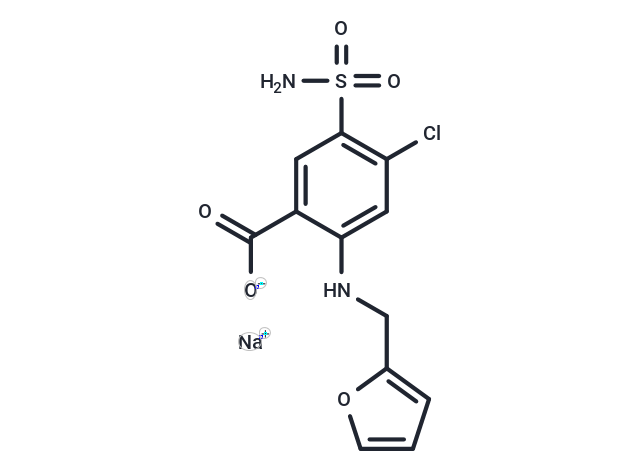Shopping Cart
- Remove All
 Your shopping cart is currently empty
Your shopping cart is currently empty

Furosemide sodium (Frusemide Sodium) is a potent and orally active inhibitor of Na+/K+/2Cl- (NKCC) cotransporter, NKCC1 and NKCC2. Furosemide sodium is also a GABAA receptors antagonist and displays 100-fold selectivity for α6-containing receptors than α1-containing receptors. Furosemide sodium acts as a loop diuretic and used for the study of congestive heart failure, hypertension and edema.

| Pack Size | Price | Availability | Quantity |
|---|---|---|---|
| 25 mg | $29 | In Stock | |
| 1 mL x 10 mM (in DMSO) | $79 | In Stock |
| Description | Furosemide sodium (Frusemide Sodium) is a potent and orally active inhibitor of Na+/K+/2Cl- (NKCC) cotransporter, NKCC1 and NKCC2. Furosemide sodium is also a GABAA receptors antagonist and displays 100-fold selectivity for α6-containing receptors than α1-containing receptors. Furosemide sodium acts as a loop diuretic and used for the study of congestive heart failure, hypertension and edema. |
| Targets&IC50 | GABAA receptor:, NKCC: |
| In vitro | Furosemide sodium, at a concentration of 500 µM administered over 72-96 hours, significantly alters the proliferation rates of MKN45 cells, a poorly differentiated human gastric adenocarcinoma cell line, while exhibiting no impact on MKN28 cells, a moderately differentiated counterpart, with MKN45 cells displaying a higher growth rate [4]. Additionally, exposures to Furosemide sodium at concentrations of 10 µM, 30 µM, and 100 µM for 45 minutes substantially reduce cation channel activity and intracellular Ca(2+) levels in human erythrocytes from healthy individuals. Conversely, Tert-butylhydroperoxide increases non-selective cation channel activity and intracellular Ca(2+) concentrations, promoting cell membrane scrambling, which is notably mitigated by Furosemide sodium [5]. |
| In vivo | Furosemide sodium (intraperitoneal injection; 100 mg/kg; single dose) is administered following kanamycin (KM) (1000 mg/kg) to establish a deaf mouse model in C57BL/6 mice. This regimen leads to the evaluation of hearing loss and cochlear hair cell damage on days 1, 2, and 3 post-injection. Marked deterioration in hearing is observed as early as the next day (Day-1 group), with the morphology of outer hair cells (OHCs) within the apical, middle, and basal turns of the cochlea becoming disorganized by day 3[1]. |
| Alias | Lasix, Frusemide Sodium |
| Molecular Weight | 352.73 |
| Formula | C12H10ClN2NaO5S |
| Cas No. | 41733-55-5 |
| Smiles | O=C([O-])C1=CC(S(=O)(N)=O)=C(Cl)C=C1NCC2=CC=CO2.[Na+] |
| Storage | Powder: -20°C for 3 years | In solvent: -80°C for 1 year | Shipping with blue ice. | |||||||||||||||||||||||||||||||||||
| Solubility Information | DMSO: 135 mg/mL (382.73 mM), Sonication is recommended. | |||||||||||||||||||||||||||||||||||
Solution Preparation Table | ||||||||||||||||||||||||||||||||||||
DMSO
| ||||||||||||||||||||||||||||||||||||

Copyright © 2015-2025 TargetMol Chemicals Inc. All Rights Reserved.